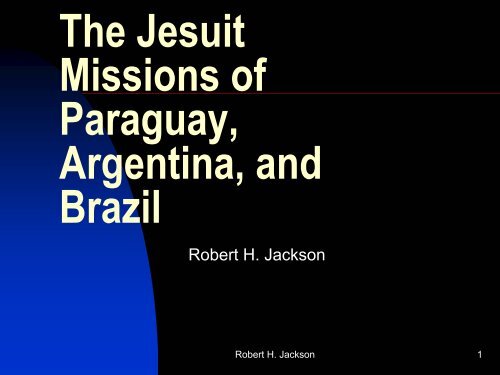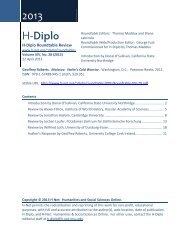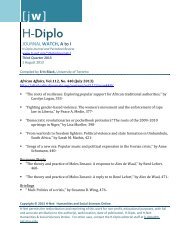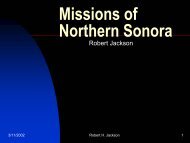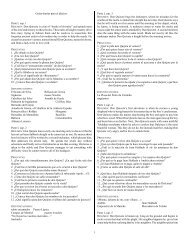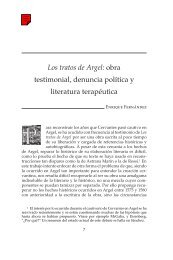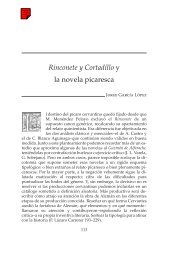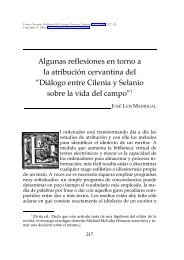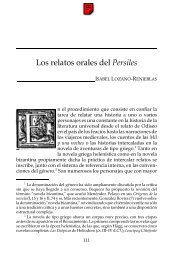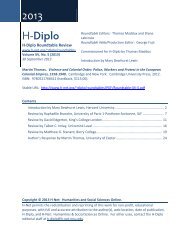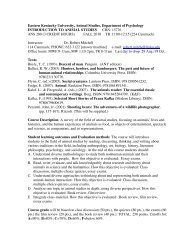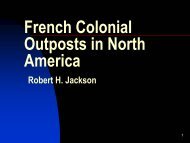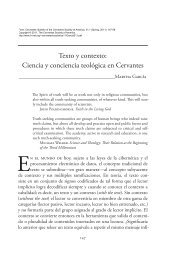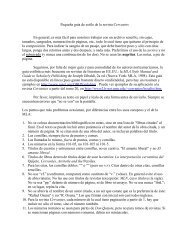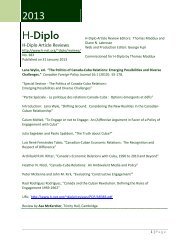The Jesuit Missions of Paraguay, Argentina, and Brazil - H-Net
The Jesuit Missions of Paraguay, Argentina, and Brazil - H-Net
The Jesuit Missions of Paraguay, Argentina, and Brazil - H-Net
Create successful ePaper yourself
Turn your PDF publications into a flip-book with our unique Google optimized e-Paper software.
<strong>The</strong> <strong>Jesuit</strong><br />
<strong>Missions</strong> <strong>of</strong><br />
<strong>Paraguay</strong>,<br />
<strong>Argentina</strong>, <strong>and</strong><br />
<strong>Brazil</strong><br />
Robert H. Jackson<br />
Robert H. Jackson 1
Introduction. Beginning in 1609, the<br />
<strong>Jesuit</strong>s established an extensive<br />
chain <strong>of</strong> missions in the borderl<strong>and</strong>s<br />
<strong>of</strong> <strong>Paraguay</strong>, <strong>Argentina</strong>, <strong>and</strong> <strong>Brazil</strong>.<br />
<strong>The</strong> <strong>Jesuit</strong> missions, also known as<br />
reducciones, were by all accounts<br />
the most successful group <strong>of</strong><br />
missions established on the fringes<br />
<strong>of</strong> Spanish America, <strong>and</strong> at their<br />
height in the early 1730s had a<br />
population <strong>of</strong> as many as 140,000<br />
Guarani. <strong>The</strong> so-called <strong>Jesuit</strong><br />
republics were the subject <strong>of</strong><br />
contemporary literature (C<strong>and</strong>ide), as<br />
well as modern literature <strong>and</strong> film (<strong>The</strong><br />
Mission).<br />
Robert H. Jackson 2
It would also be accurate to say that the<br />
reducciones experienced a tumultuous<br />
history. In the 1620s <strong>and</strong> 1630s, slave<br />
raiders from Sao Paulo (b<strong>and</strong>eirantes),<br />
forced the <strong>Jesuit</strong>s to relocate a number <strong>of</strong><br />
missions, until they organized a Guarani<br />
militia <strong>and</strong> defeated the raiders in 1641.<br />
<strong>The</strong> Guarani militia became a useful tool<br />
to the Spanish government in the region,<br />
but was also a source <strong>of</strong> tension with the<br />
local settlers. In 1750, Spain <strong>and</strong> Portugal<br />
signed the Treaty <strong>of</strong> Madrid to establish<br />
the boundaries between Spanish <strong>and</strong><br />
Portuguese territory in South America.<br />
Portugal was to receive the seven<br />
missions located east <strong>of</strong> the Uruguay<br />
River, <strong>and</strong> the Guarani were to relocate.<br />
Instead they revolted, leading to the socalled<br />
Guarani War.<br />
Robert H. Jackson 3
At the same time the missions prospered,<br />
<strong>and</strong> the missions became major<br />
participants in the regional economy,<br />
selling yerba mate, cattle hides, cotton,<br />
<strong>and</strong> other products throughout the region.<br />
<strong>The</strong> basis for the mission economy was<br />
the division between communal<br />
production <strong>and</strong> production by each<br />
Guarani family.<br />
Robert H. Jackson 4
<strong>The</strong> <strong>Jesuit</strong>s directed the construction <strong>of</strong><br />
extensive building complexes, that<br />
included a church <strong>and</strong> perhaps chapels,<br />
residence for the missionaries,<br />
workshops, the “coty Guazu” or residence<br />
for widows, <strong>and</strong> houses for the Guarani<br />
neophytes. Initially, the buildings were <strong>of</strong><br />
wattle <strong>and</strong> daub or adobe, but in the early<br />
<strong>and</strong> mid-eighteenth century the <strong>Jesuit</strong>s<br />
initiated a major reconstruction using<br />
stone or stone <strong>and</strong> adobe. Wars in the first<br />
decades <strong>of</strong> the nineteenth century<br />
resulted in the destruction <strong>of</strong> most <strong>of</strong> the<br />
missions, <strong>and</strong> today only ruins survive as<br />
a testimony to the effort to create<br />
Christian utopias, reminiscent <strong>of</strong> the<br />
primitive early Christian communities, in<br />
South America.<br />
Robert H. Jackson 5
<strong>The</strong> <strong>Jesuit</strong> missions<br />
occupied sites along the<br />
Parana <strong>and</strong> Uruguay<br />
Rivers, but the territory<br />
<strong>of</strong> the missions was<br />
much more extensive<br />
when including the<br />
estancias or cattle<br />
ranches that covered<br />
thous<strong>and</strong>s <strong>of</strong> acres.<br />
Robert H. Jackson 6
1750 map <strong>of</strong> <strong>Jesuit</strong><br />
missions<br />
Robert H. Jackson 7
1750 map <strong>of</strong> disputed territories in the Rio<br />
de la Plata region<br />
Robert H. Jackson 8
<strong>Missions</strong> <strong>and</strong> estancias<br />
Robert H. Jackson 9
<strong>The</strong> Guarani population in the<br />
<strong>Jesuit</strong> missions was a high<br />
fertility <strong>and</strong> high mortality<br />
population. Guarani women bore<br />
children, but mortality rates were<br />
also high <strong>and</strong> the population<br />
experienced low to moderate<br />
rates <strong>of</strong> growth. Periodic<br />
epidemics culled the<br />
populations, but there generally<br />
was a rebound or recovery<br />
following the epidemic<br />
outbreaks.<br />
Robert H. Jackson 10
160000<br />
140000<br />
120000<br />
100000<br />
80000<br />
60000<br />
40000<br />
20000<br />
0<br />
Population <strong>of</strong> the <strong>Jesuit</strong><br />
missions<br />
Population<br />
Robert H. Jackson 11<br />
1647<br />
1653<br />
1659<br />
1665<br />
1671<br />
1677<br />
1683<br />
1689<br />
1695<br />
1701<br />
1707<br />
1713<br />
1719<br />
1725<br />
1731<br />
1737<br />
1743<br />
1749<br />
1755<br />
1761<br />
1767<br />
1773<br />
1779<br />
1785<br />
1791<br />
1797<br />
Year<br />
Population
4000<br />
3500<br />
3000<br />
2500<br />
2000<br />
1500<br />
1000<br />
500<br />
0<br />
Population <strong>of</strong> C<strong>and</strong>elaria<br />
mission<br />
Population<br />
Robert H. Jackson 12<br />
1647<br />
1653<br />
1659<br />
1665<br />
1671<br />
1677<br />
1683<br />
1689<br />
1695<br />
1701<br />
1707<br />
1713<br />
1719<br />
1725<br />
1731<br />
1737<br />
1743<br />
1749<br />
1755<br />
1761<br />
1767<br />
1773<br />
1779<br />
1785<br />
1791<br />
1797<br />
Year<br />
Population
1675<br />
1668<br />
1661<br />
1654<br />
5000<br />
4500<br />
4000<br />
3500<br />
3000<br />
2500<br />
2000<br />
1500<br />
1000<br />
500<br />
0<br />
Population <strong>of</strong> Itapua mission<br />
Population<br />
1682<br />
1689<br />
1696<br />
1703<br />
1710<br />
1717<br />
1724<br />
1731<br />
1738<br />
1745<br />
1752<br />
1759<br />
1766<br />
1773<br />
1780<br />
1787<br />
1794<br />
1801<br />
Year<br />
Robert H. Jackson 13<br />
1647<br />
Population
1675<br />
1668<br />
1661<br />
1654<br />
5000<br />
4500<br />
4000<br />
3500<br />
3000<br />
2500<br />
2000<br />
1500<br />
1000<br />
500<br />
0<br />
Population <strong>of</strong> San Ignacio<br />
mission<br />
Population<br />
1682<br />
1689<br />
1696<br />
1703<br />
1710<br />
1717<br />
1724<br />
1731<br />
1738<br />
1745<br />
1752<br />
1759<br />
1766<br />
1773<br />
1780<br />
1787<br />
1794<br />
1801<br />
Year<br />
Robert H. Jackson 14<br />
1647<br />
Population
1668<br />
1661<br />
1654<br />
8000<br />
7000<br />
6000<br />
5000<br />
4000<br />
3000<br />
2000<br />
1000<br />
0<br />
Population <strong>of</strong> Loreto mission<br />
Population<br />
1675<br />
1682<br />
1689<br />
1696<br />
1703<br />
1710<br />
1717<br />
1724<br />
1731<br />
1738<br />
1745<br />
1752<br />
1759<br />
1766<br />
1773<br />
1780<br />
1787<br />
1794<br />
1801<br />
Year<br />
Robert H. Jackson 15<br />
1647<br />
Population
A h<strong>and</strong>ful <strong>of</strong><br />
contemporary<br />
diagrams <strong>of</strong> the<br />
<strong>Jesuit</strong> reductions<br />
survive<br />
Robert H. Jackson 16
San Miguel<br />
Robert H. Jackson 17
C<strong>and</strong>elaria, the<br />
“capital” <strong>of</strong> the <strong>Jesuit</strong><br />
missions<br />
Robert H. Jackson 18
San Juan Bautista<br />
Robert H. Jackson 19
By the 1750s <strong>and</strong> 1760s, the <strong>Jesuit</strong>s had<br />
had the missions rebuilt using the grid<br />
plan. A large central plaza occupied a<br />
central place in the community, <strong>and</strong> the<br />
church <strong>and</strong> other major structures were<br />
built around the plaza. <strong>The</strong> ruins that can<br />
be seen at many <strong>of</strong> the mission sites<br />
reflect decades <strong>of</strong> building.<br />
Robert H. Jackson 20
Diagram <strong>of</strong> Loreto<br />
mission<br />
Robert H. Jackson 21
Diagram <strong>of</strong> San Ignacio<br />
Mini mission<br />
Robert H. Jackson 22
<strong>Missions</strong> in<br />
<strong>Paraguay</strong><br />
Robert H. Jackson 23
San Ignacio Guasu<br />
Robert H. Jackson 24
Santiago<br />
Robert H. Jackson 25
Santiago<br />
Robert H. Jackson 26
Santiago<br />
Robert H. Jackson 27
Santa Rosa<br />
Robert H. Jackson 28
Trinidad de Parana<br />
Robert H. Jackson 29
Trinidad de Parana<br />
Robert H. Jackson 30
Jesus de Tavarangue<br />
Robert H. Jackson 31
Jesus de Tavarangue<br />
Robert H. Jackson 32
Jesus de Tavarangue<br />
Robert H. Jackson 33
San Cosme<br />
Robert H. Jackson 34
<strong>Missions</strong> in <strong>Argentina</strong><br />
Robert H. Jackson 35
La Cruz<br />
Robert H. Jackson 36
Yapeyu<br />
Robert H. Jackson 37
San Carlos<br />
Robert H. Jackson 38
San Carlos<br />
Robert H. Jackson 39
San Ignacio<br />
Robert H. Jackson 40
San Ignacio<br />
Robert H. Jackson 41
San Ignacio<br />
Robert H. Jackson 42
C<strong>and</strong>elaria<br />
Robert H. Jackson 43
Santa Ana<br />
Robert H. Jackson 44
Loreto<br />
Robert H. Jackson 45
Santa Maria la Mayor<br />
Robert H. Jackson 46
<strong>Missions</strong> in <strong>Brazil</strong><br />
Robert H. Jackson 47
San Miguel (Sao Miguel)<br />
Robert H. Jackson 48
San Miguel (Sao Miguel)<br />
Robert H. Jackson 49
Diagram <strong>of</strong> San Juan<br />
Bautista (Sao Joao<br />
Batista)<br />
Robert H. Jackson 50
San Juan Bautista (Sao<br />
Joao Batista)<br />
Robert H. Jackson 51
San Juan Bautista (oao<br />
Joao Batista)<br />
Robert H. Jackson 52
Excavations at San Juan<br />
Bautista (Sao Joao<br />
Batista)<br />
Robert H. Jackson 53
San Lorenzo (Sao<br />
Lourenco)<br />
Robert H. Jackson 54
San Nicolas (Sao<br />
Nicolau)<br />
Robert H. Jackson 55
<strong>The</strong> <strong>Jesuit</strong> missions became<br />
targets in the wars in the first<br />
decades <strong>of</strong> the 19 th century<br />
between <strong>Paraguay</strong>, <strong>Argentina</strong>,<br />
<strong>and</strong> Portugal/<strong>Brazil</strong>. Armies<br />
occupied <strong>and</strong> sacked most <strong>of</strong><br />
the missions. <strong>The</strong> missions<br />
fell into ruin, <strong>and</strong> the<br />
surrounding forests<br />
encroached on them.<br />
Efforts to stabilize <strong>and</strong> protect<br />
the ruins only began in the<br />
mid-20 th century.<br />
Robert H. Jackson 56
San Ignacio ruins in 1940<br />
Robert H. Jackson 57


